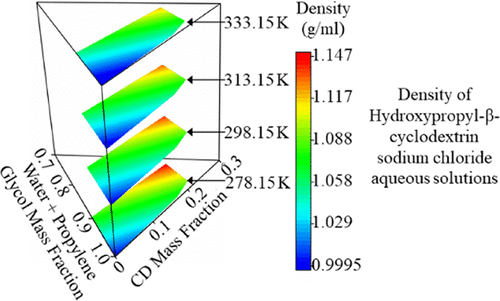当前位置:
X-MOL 学术
›
J. Chem. Eng. Data
›
论文详情
Our official English website, www.x-mol.net, welcomes your
feedback! (Note: you will need to create a separate account there.)
Solution Density Models as Functions of Sodium Chloride, Hydroxypropyl-β-cyclodextrin, and Temperature (278.15–333.15 K) via Progressive Linear and Stepwise Regression
Journal of Chemical & Engineering Data ( IF 2.0 ) Pub Date : 2020-09-24 , DOI: 10.1021/acs.jced.0c00093 William J. Blanford 1 , David S. Jofat 1 , Adam D. Kapelner 2
Journal of Chemical & Engineering Data ( IF 2.0 ) Pub Date : 2020-09-24 , DOI: 10.1021/acs.jced.0c00093 William J. Blanford 1 , David S. Jofat 1 , Adam D. Kapelner 2
Affiliation

|
Knowledge of solution density as a function of levels of cyclodextrin (CDs), salt, and temperature is crucial in the production of cyclodextrins, evaluation of guest–host interactions, and many applications of CDs especially in aquifer remediation and advanced oil recovery where density affects hydraulics. Relatively high precision measurements (±1 μg·cm–3) of solution density at 1 atm were collected from 278.15 to 333.15 K for aqueous solutions of 2-hydroxypropyl-β-cyclodextrin and sodium chloride. A progressive model (0.0021, 95% CI) based on observed trends in data was developed by observations of second-order relationships for temperature and salinity in molal and linear CD concentration. In a less biased manner, a novel approach to developing density equations involved creation of a series of ordinary least squares (OLS) linear models based on a stepwise adoption of additional “best” terms from a pool of 3872 variants of terms commonly found in density and other rheological equations based on minimization of the Akaike information criterion. After evaluating the use of up to 83 terms, no improvement was gained for a molal-based concentration after 79 terms and mass fraction based after 77 terms with both having a 95% prediction interval of 32.4 μg·cm–3 being achieved. For potential end-users, the provided pool of 186 OLS models enables the choice of complexity versus performance for their application. More broadly, the methods used herein can be adopted for development of accurate equations for other rheological systems.
中文翻译:

逐步线性和逐步回归的溶液密度模型作为氯化钠,羟丙基-β-环糊精和温度(278.15–333.15 K)的函数
溶液密度随环糊精(CDs),盐和温度的变化而变化的知识对于生产环糊精,评估客体与宿主之间的相互作用以及CD的许多应用至关重要,特别是在密度影响的含水层修复和高级采油中液压系统。相对高精度的测量(±1μg·cm –3对于2-羟丙基-β-环糊精和氯化钠水溶液,从278.15至333.15 K收集1 atm的溶液密度)。通过观察摩尔和线性CD浓度的温度和盐度的二阶关系,建立了基于观察到的数据趋势的渐进模型(0.0021,95%CI)。以较少偏见的方式,开发密度方程式的新方法涉及创建一系列普通最小二乘法(OLS)线性模型,该模型基于逐步采用密度中常见的3872个术语变体库中的其他“最佳”术语以及基于Akaike信息准则最小化的其他流变方程。在评估了多达83个术语的使用后,–3正在实现。对于潜在的最终用户,所提供的186种OLS模型库使他们能够针对其应用选择复杂性与性能的选择。更广泛地讲,本文中使用的方法可以用于开发其他流变系统的精确方程。
更新日期:2020-10-08
中文翻译:

逐步线性和逐步回归的溶液密度模型作为氯化钠,羟丙基-β-环糊精和温度(278.15–333.15 K)的函数
溶液密度随环糊精(CDs),盐和温度的变化而变化的知识对于生产环糊精,评估客体与宿主之间的相互作用以及CD的许多应用至关重要,特别是在密度影响的含水层修复和高级采油中液压系统。相对高精度的测量(±1μg·cm –3对于2-羟丙基-β-环糊精和氯化钠水溶液,从278.15至333.15 K收集1 atm的溶液密度)。通过观察摩尔和线性CD浓度的温度和盐度的二阶关系,建立了基于观察到的数据趋势的渐进模型(0.0021,95%CI)。以较少偏见的方式,开发密度方程式的新方法涉及创建一系列普通最小二乘法(OLS)线性模型,该模型基于逐步采用密度中常见的3872个术语变体库中的其他“最佳”术语以及基于Akaike信息准则最小化的其他流变方程。在评估了多达83个术语的使用后,–3正在实现。对于潜在的最终用户,所提供的186种OLS模型库使他们能够针对其应用选择复杂性与性能的选择。更广泛地讲,本文中使用的方法可以用于开发其他流变系统的精确方程。











































 京公网安备 11010802027423号
京公网安备 11010802027423号